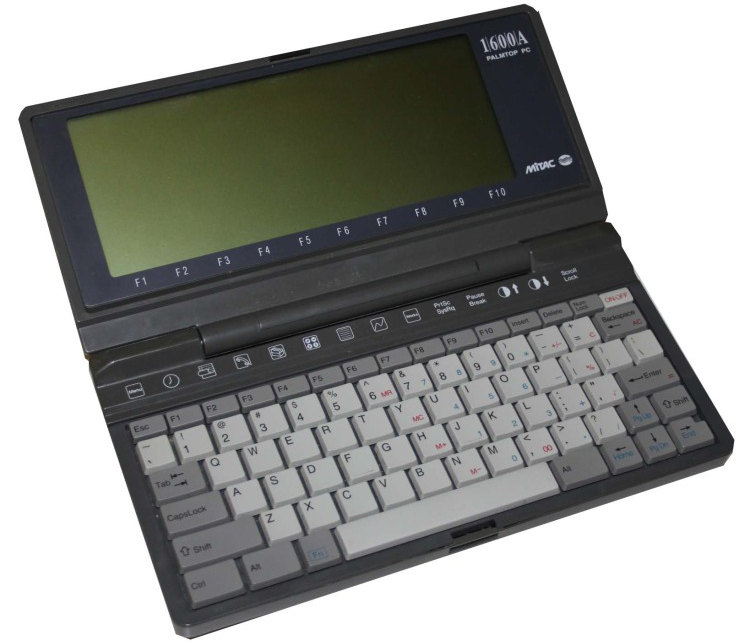Mitac 1600A Palmtop PC

About this machine:
Unlike my original assumption this is not a tidalwave clone and thus the only one i know that also has MS-Works in ROM and not a Tidalwave PS-1000 clone. Some sites had this one incorrectly listed as "1600AA" while it is actually just "1600A". Interestingly "Mitac International Corp" - which is a Taiwanese company - is still in business. The 1600A seems to have had some quality problems - Users reported failing screens and backup battery connectors that didn't work. Also the PIM seems to have a bug where you can't add contacts any more after the memory is already pretty full. This is a bit of an oddball. As i mentioned - when i first saw it i immediately thought it to be a tidalwave. The size, MS-DOS 5, MS-Works, 2 PCMCIA 1.0 slots... But once you hold this machine in your hands and plays with it for a while the differences become clear. Not all differences are an advantage though. At first I'd like to mention the liberal boot modes. While the Tidalwave machines insist on loading their MS-DOS 5.0 from ROM you can boot from PCMCIA here. Actually you "must" boot from PCMCIA if you have a Card in Slot "A". If you have any Card in Slot "A" while turning on the device and that Card is not formatted as a System disk the boot process will hang telling you "Non system disk". Oddly there is also an option to boot from floppy. No there is no floppy for the 1600A - you actually use your desktops floppy drive. Well after installing a server software and connecting the palmtop via serial cable that is. The cable is an oddball as well - only one proprietary connector and the "optional" cable is big, thick and has both a split serial and parallel connector on it. Not too handy to carry around with you if you only wanna connect a mouse. The batteries are also a rather weird choice, only palmtop i know to use the AAA type and directly 4 of them. Another unique feature is the ability to use a PCMCIA SRAM Card as an "EMS Card". For that you have to insert the card in the "B" slot and format it with a special command. The only notable app i can think of that makes use of EMS is however Windows 3.0 - and even here it makes limited sense since you won't find too many Windows 3.0 appz that run in real mode. There are other small differences that make the Mitac easy to tell apart from the Tidalwave clones, like for example the key combination to adjust the contrast.
Specs:
CPU: Chips and Technology 8680 @ 7.1 MHz
Graphics: Monochrome CGA, 80 x 25 character text mode, CGA 2 color monochrome graphics mode
Display: 640 x 200 monochrome Supertwist LCD , 4 grey scales, 7.2 inch
Memory (RAM): 1 MB
ROM (Software): 1.5 MB
I/O ports: RS232 Serial and parallel (proprietary dual use cable was optional accessory), PCMCIA 1.0 Type I slot
Sound: PC Speaker - Piezo
Operating System: MS-DOS 5.0
Software: MS Works 2.0, PCLinks, PIM
Size: Length 11.5 cm, Width 23.0 cm, Height 3.0 cm (4.5 inches x 9.0 inches x 1.1 inch)
Powered by: 4 AAA batteries - rechargable or non-rechargable or AC adaptor (optional accessory), CR2032 Lithium button cell as memory backup
Weight: 560 gram
Special features: Can boot from Desktop Computer floppy disk drive
Released: 1992
Originally retailed for:: 400 British Pound (199 pound in November 1993)
Clone of: None
Similar models: Tidalwave PS-1000, Highscreen Handy Organizer and all other tidalwave clones
Pros:
- Fully CGA compliant, so most CGA based DOS appz and games work
- Excellent keyboard
- Good boot options
Cons:
- PCMCIA Type I won't let you access any flash cards without a driver
- Not really the smallest Palmtop ever
- Power management is rather average
- Reported by several users to be pretty unreliable
- Weird and bulky cable
Collector Value:
9 of 10
Usage Value:
7 of 10
Verdict:
Looks like a tidalwave clone, but it isn't. Rather rare. The only one i know to use AAA Batteries. And the only one to boot from your desktops floppy disk drive. Otherwise pretty much like all other TidalWave clones. Refreshingly different, but due to the big size, weight and limited capabilities not the most useful DOS palmtop around.
Back to the Palmtop PC index
